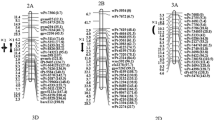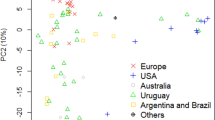Abstract
The orderly development of winter wheat through its life cycle can be marked at three stages: stem elongation, heading date, and physiological maturity. The duration of a developmental phase between two stages is important in yield component generation. In this study the three developmental stages were characterized and 350 markers were mapped in a population of recombinant inbred lines (RILs) generated from a cross between two winter wheat cultivars (‘Jagger’ and ‘2174’). Three major QTLs were found to control variation in developmental process, and each of them was tightly associated with a known flowering gene, VRN-A1 on chromosome 5A, PPD-D1 on chromosome 2D, and VRN-D3 on chromosome 7D. The average contribution of the gene marker for each QTL to the total phenotypic variation (R 2) was evaluated over 3 years. The effect of VRN-A1 ranged from 21.5% at stem elongation to 17.4% at physiological maturity. The effect of PPD-D1 was minor (6.7%) at stem elongation but increased to 29.7% at heading and 20.1% at physiological maturity. The effect of VRN-D3 was not detected at stem elongation but increased to 14.6% at heading and to 20.5% at physiological maturity. Hence, the VRN-A1 locus, the PPD-D1 locus, and the VRN-D3 locus had greatest impact on development at stem elongation, heading date, and physiological maturity, respectively. Whereas the Jagger VRN-A1 and VRN-D3 alleles accelerated development, the Jagger PPD-D1 allele delayed the developmental process due to its sensitivity to photoperiod. Our findings suggest that through the appropriate combination of alleles at these three loci one would be able to regulate the various developmental phases to accommodate different agricultural needs.


Similar content being viewed by others
References
Amasino R (2004) Vernalization, competence, and the epigenetic memory of winter. Plant Cell 16:2553–2559
Beales J, Turner A, Griffiths S, Snape J, Laurie D (2007) A pseudo-response regulator is misexpressed in the photoperiod insensitive Ppd-D1a mutant of wheat (Triticum aestivum L.). Theors Appl Genet 115:721–733
Bonnin I, Rousset M, Madur D, Sourdille P, Dupuits C, Brunel D, Goldringer T (2008) FT genome A and D polymorphisms are associated with the variation of earliness components in hexaploid wheat. Theor Appl Genet 116:383–394
Chen Y, Carver BF, Wang S, Zhang F, Yan L (2009) Genetic loci associated with stem elongation and winter dormancy release in wheat. Theor Appl Genet 118:881–889
Danyluk J, Kane NA, Breton G, Limin AE, Fowler DB, Sarhan F (2003) TaVRT-1, a putative transcription factor associated with vegetative to reproductive transition in cereals. Plant Physiol 132:1849–1860
Dubcovsky J, Loukoianov A, Fu D, Valarik M, Sanchez A, Yan L (2006) Effect of photoperiod on the regulation of wheat vernalization genes VRN1 and VRN2. Plant Mol Biol 60:469–480
Edwards JT, Carver BF, Payton ME (2007) Relationship of first hollow stem and heading in winter wheat. Crop Sci 47:2074–2077
Fowler DB, Breton G, Limin AE, Mahfoozi S, Sarhan F (2001) Photoperiod and temperature interactions regulate low-temperature-induced gene expression in barley. Plant Physiol 127:1676–1681
Fu DL, Szucs P, Yan L, Helguer M, Skinner JS, von Zitzewitz J, Hayes PM, Dubcovsky J (2005) Large deletions within the first intron in VRN-1 are associated with spring growth habit in barley and wheat. Mol Genet Genomics 273:54–65
Gonzalez FG, Slafer GA, Miralles DJ (2002) Vernalization and photoperiod responses in wheat pre-flowering reproductive phases. Field Crops Res 74:183–195
Gonzalez FG, Slafer GA, Miralles DJ (2003) Grain and floret number in response to photoperiod during stem elongation in fully and slightly vernalized wheats. Field Crops Res 81:17–27
Haun JR (1973) Visual quantification of wheat development. Agron J 65:116–119
Hay RKM, Ellis RP (1998) The control of flowering in wheat and barley: what recent advances in molecular genetics can reveal. Ann Bot 82:541–554
Hay RKM, Kirby EJM (1991) Convergence and synchrony—a review of the coordination of development in wheat. Aus J Agri Res 42:661–700
Košner J, Pánková K (1998) The detection of allelic variants at the recessive vrn loci of winter wheat. Euphytica 101:9–16
Kuchel H, Hollamby G, Langridge P, Williams K, Jefferies S (2006) Identification of genetic loci associated with ear-emergence in bread wheat. Theor Appl Genet 113:1103–1112
Laurie DA, Pratchett N, Bezant JH, Snape JW (1995) RFLP mapping of five major genes and eight quantitative trait loci controlling flowering time in a winter x spring barley Hordeum vulgare (L) cross. Genome 38:575–585
Law CN, Worland AJ (1997) Genetic analysis of some flowering time and adaptive traits in wheat. New Phytol 137:19–28
Levy YY, Mesnage S, Mylne JS, Gendall AR, Dean C (2002) Multiple roles of Arabidopsis VRN1 in vernalization and flowering time control. Science 297:243–246
McMaster GS (2009) Development of the wheat plant. In: Carver BF (ed) Wheat: science and trade. Blackwell, IA, pp 31–50
Murai K, Miyamae M, Kato H, Takumi S, Ogihara Y (2003) WAP1, a wheat APETALA1 homolog, plays a central role in the phase transition from vegetative to reproductive growth. Plant & Cell Physiol 44:1255–1265
Pidal B, Yan L, Fu D, Zhang F, Tranquilli G, Dubcovsky J (2009) The CArG-box in the promoter region of wheat vernalization gene VRN1 is not necessary to mediate the vernalization response. J Hered. doi:10.1093/jhered/esp002
Pugsley AT (1971) A genetic analysis of the spring-winter habit of growth in wheat. Aust J Agric Res 22:21–31
Ratcliffe OJ, Amaya I, Vincent CA, Rothstein S, Carpenter R, Coen ES, Bradley DJ (1998) A common mechanism controls the life cycle and architecture of plants. Development 125:1609–1615
Redmon LA, Krenzer EG, Bernardo DJ, Horn GW (1996) Effect of wheat morphological stage at grazing termination on economic return. Agron J 88:94–97
Snape JW, Butterworth K, Whitechurch E, Worland AJ (2001) Waiting for fine times: genetics of flowering time in wheat. Euphytica 119:185–190
Szűcs P, Skinner J, Karsai I, Cuesta-Marcos A, Haggard K, Corey A, Chen T, Hayes P (2007) Validation of the VRN-H2/VRN-H1 epistatic model in barley reveals that intron length variation in VRN-H1 may account for a continuum of vernalization sensitivity. Mol Gen Genomics 277:249–261
Tasma IM, Shoemaker RC (2003) Mapping flowering time gene homologs in soybean and their association with maturity (E) loci. Crop Sci 43:319–328
Tranquilli GE, Dubcovsky J (2000) Epistatic interactions between vernalization genes Vrn-A m 1 and Vrn-A m 2 in diploid wheat. J Hered 91:304–306
Trevaskis B, Bagnall DJ, Ellis MH, Peacock WJ, Dennis ES (2003) MADS box genes control vernalization-induced flowering in cereals. Proc Natl Acad Sci USA 100:13099–13104
Trevaskis B, Hemming MN, Peacock WJ, Dennis ES (2006) HvVRN2 responds to daylength, whereas HvVRN1 is regulated by vernalization and developmental status. Plant Physiol 140:1397–1405
Von Zitzewitz J, Szûcs P, Dubcovsky J, Yan L, Francia E, Pecchioni N, Casas A, Chen THH, Hayes PM, Skinner JS (2005) Molecular and structural characterization of barley vernalization genes. Plant Mol Biol 59:449–467
Wang S, Carver BF, Yan L (2009) Genetic loci in the photoperiod pathway interactively modulate reproductive development of winter wheat. Theor App Genet 118:1339–1349
White JW, Herndl M, Hunt LA, Payne TS, Hoogenboom G (2008) Simulation-based analysis of effects of Vrn and Ppd loci on flowering in wheat. Crop Sci 48:678–687
Whitechurch EM, Slafer GA (2001) Responses to photoperiod before and after jointing in wheat substitution lines. Euphytica 118:47–51
Whitechurch EM, Slafer GA (2002) Contrasting Ppd alleles in wheat: effects on sensitivity to photoperiod in different phases. Field Crops Res 73:95–105
Yan L (2009) The wheat flowering pathway. In: Carver BF (ed) Wheat: science and trade. IA, Blackwell, pp 57–67
Yan L, Loukoianov A, Tranquilli G, Helguera M, Fahima T, Dubcovsky J (2003) Positional cloning of wheat vernalization gene VRN1. Proc Natl Acad Sci USA 100:6263–6268
Yan L, Loukoianov A, Tranquilli G, Blechl A, Khan IA, Ramakrishna W, SanMiguel P, Bennetzen JL, Echenique V, Lijavetzky D, Dubcovsky J (2004) The wheat VRN2 gene is a flowering repressor down-regulated by vernalization. Science 303:1640–1644
Yan L, Fu D, Li C, Blechl A, Tranquilli G, Bonafede M, Sanchez A, Valarik M, Yasuda S, Dubcovsky J (2006) From the cover: the wheat and barley vernalization gene VRN3 is an orthologue of FT. Prod Natl Acad Sci USA 103:19581–19586
Zadoks J, Chang T, Konzak C (1974) A decimal code for growth stages of cereals. Weed Res 14:415–421
Acknowledgments
This study was supported by the National Research Initiative of the USDA-Cooperative State Research, Education and Extension Service, grant number 2006-55606-16629 (CAP) and grant number 2007-35301-18188, the Oklahoma Center of Advanced Science and Technology (OCAST), the Oklahoma Wheat Research Foundation, and the Oklahoma Agricultural Experiment Station.
Author information
Authors and Affiliations
Corresponding author
Rights and permissions
About this article
Cite this article
Chen, Y., Carver, B.F., Wang, S. et al. Genetic regulation of developmental phases in winter wheat. Mol Breeding 26, 573–582 (2010). https://doi.org/10.1007/s11032-010-9392-6
Received:
Accepted:
Published:
Issue Date:
DOI: https://doi.org/10.1007/s11032-010-9392-6




